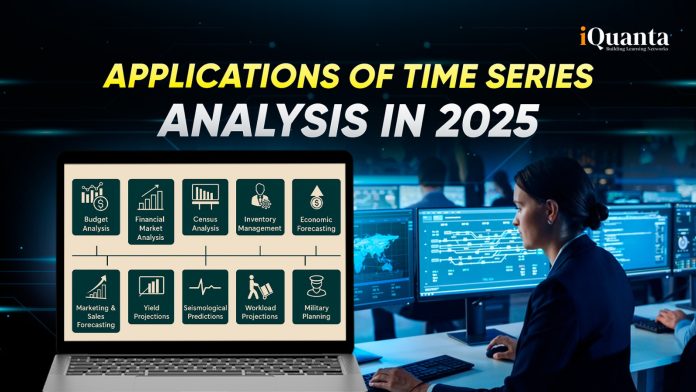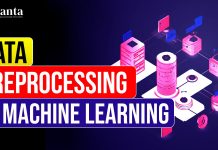In current scenarios, understanding how things can change over time is more important than ever. Time Series Analysis is a concept which is used to analyze data points collected or recorded at specific time intervals that become an important tool across various industries.
From predicting stock prices to monitor patients, time series analysis plays some important role in most critical business and technology decisions.
As we move into 2025, the importance of time series analysis continues to grow with the rise of real time data, IoT devices and AI. Business and some big companies do not want to understand what is happening, rather they want to predict what will happen next in the future regarding a particular solution.
With advanced algorithms, tools and techniques, time series analysis and forecasting has evolved very fast with a main skill.
In this blog, we will explore the top 10 applications of time series analysis in 2025, showcasing how this powerful technique helps you shape a successful future.
What is Time Series Analysis?
Time series analysis is a very important concept and it is the study of data points to be collected at a regular time intervals to cover various trends and patterns. Unlike unordered data, time series data is more sequential (or in ordered form). This method helps in forecasting future events based on the historical data. In data science it is very important concept to learn.

Example : A retail company tracking monthly sales over the past three years that can use time series analysis to forecast next month’s salaries. By identifying trends and patterns, businesses can make data-driven decisions. Time Series Analysis like ARIMA or facebook Prophets are used for such predictions.
Why Time Series Analysis Matters in 2025?
As we enter a world where real-time data is more important, time series analysis has become more essential than ever. In 2025, organizations are not just looking to understand your past performance but they want to know or understand future trends and respond upon it. With the explosion of IoT devices, sensor networks, and digital transactions. Businesses now have access to massive volumes of related data. From predicting energy and monitoring patient health to forecasting customers behavior, time series analysis enables smarter and data-driven decisions. The integration of AI and machine learning into time series models has also have more accurate, scalable and automated solutions.
Moreover in a fast changing environment, having the ability to detect errors, adjust to real time data shifts and generate reliable future predictions is a major advantage. In 2025, time series analysis is not just a technical tool but it is very important across major industries.
Applications of Time Series Analysis in 2025
The applications of time series analysis in 2025 are transforming how industries forecast, plan, and make decisions. With growing access to real-time and historical data, companies across all sectors are using time series techniques to stay competitive. Let’s look at some of the most important use cases this year.
Stock Market Prediction
One of the most well-known applications of time series analysis is in the stock market. Financial analysts use time series models to predict future stock prices, identify market trends, and detect anomalies. Tools like ARIMA, LSTM, and Facebook Prophet help automate investment strategies and risk management in real time.
Weather Forecasting
Weather forecasting is a classic yet evolving application of time series analysis. Meteorological departments analyze historical climate patterns, temperatures, and pressure variations to predict future conditions. In 2025, machine learning enhances accuracy even in extreme weather scenarios.
Sales and Demand Forecasting
Retailers and eCommerce companies rely heavily on time series analysis to forecast future demand, manage inventory, and optimize supply chains. With seasonal patterns and promotional spikes, advanced forecasting models ensure businesses never overstock or under-deliver.
Energy Consumption Forecasting
Similarly, energy providers use time series data to understand and predict daily or hourly usage. These applications of time series analysis help them manage supply, reduce waste, and support cleaner energy grids by matching demand with availability.
Healthcare Monitoring
Time series analysis also plays a major role in healthcare. For instance, doctors can monitor heart rate or blood pressure data over time to detect early warning signs. Moreover, hospitals use this data to prepare for patient spikes or monitor chronic illnesses.
Predictive Maintenance
In manufacturing and transport industries, predictive maintenance is one of the fastest-growing applications of time series analysis. By monitoring machine performance over time, companies can predict when a part might fail and fix it before it breaks down by saving money and avoiding delays.
Economic and Financial Forecasting
Moreover, economists use time series models to forecast trends in inflation, GDP, and unemployment. These applications of time series analysis help governments make smarter policies and allow businesses to plan for economic changes.
Traffic and Mobility Forecasting
With the rise of smart cities, traffic and mobility data are more important than ever. Time series analysis helps urban planners predict traffic jams, plan new routes, and optimize public transport systems based on changing patterns throughout the day.
Call Volume and Resource Planning
One of the applications of time series analysis is used in customer service, time series data is used to forecast call volumes. Because of this, companies can schedule staff efficiently, reduce waiting times, and improve the overall customer experience.
Social Media and Trend Analysis
Finally, a modern applications of time series analysis lies in tracking trends on social media. By analyzing how engagement changes over hours or days, marketers can post content at the right time and stay ahead of viral trends.
Tools Used for Time Series Analysis
There are major tools that we are using in time series analysis. The tools are described in the table given below:
| Tool / Library | Platform | Key Features | Common Applications |
| Pandas | Python | Time indexing, resampling, rolling averages | Basic time series analysis and data prep |
| Statsmodels | Python | ARIMA, SARIMA, statistical models | Classical forecasting and trend modeling |
| Facebook Prophet | Python / R | Seasonality, holiday effects, easy-to-use | Business and sales forecasting |
| Keras / TensorFlow | Python | LSTM, RNN, GRU for deep learning | Predictive modeling on complex time series |
| Power BI | Microsoft Tool | Time-based charts, trendlines, visuals | Business dashboards and reports |
| Amazon Forecast | AWS Cloud | Scalable, automated forecasting | Enterprise-grade demand and sales forecasting |
| Darts | Python | Unified API for ML, DL, and ARIMA models | Fast experimentation across models |
Real-World Case Studies
- Amazon uses time series analysis to predict product demands during their own big events like Amazon Prime Day, Holidays and some others.
- Google uses time series models to search queries to estimate different outbreaks. It shows how time series data could be used for real time public health monitoring.
- Netflix tracks user activity patterns over time to recommend content and schedule new releases when engagement is highest.
Conclusion
Time Series Analysis is used everywhere in 2025. From predicting weather to knowing when people or what people will shop the most, it helps businesses and governments to make smarter decisions. It’s not just for experts but many tools now make it easier for anyone to work with time-based data.
Whether you are looking at stock prices, patient health, or traffic patterns, the time series analysis helps you to understand what’s likely to happen next in the process. As more data becomes available every second, this skill is becoming more useful than ever. If you want to start your journey to understand better about forecasting and data prediction, learning time series analysis is a great place to start.
FAQs
What are the main applications of time series analysis?
The main applications of time series analysis include stock market prediction, sales forecasting, weather forecasting, energy demand prediction, healthcare monitoring, and traffic flow analysis. These applications help businesses and governments make better, data-driven decisions based on trends over time.
Why are the applications of time series analysis important in 2025?
In 2025, the applications of time series analysis are more important than ever due to the rise of real-time data from IoT devices, sensors, and online platforms. Time series helps organizations react faster, plan smarter, and automate forecasting with greater accuracy.
How do businesses use the applications of time series analysis?
Businesses use the applications of time series analysis to forecast demand, plan inventory, optimize pricing, and track customer behavior. For example, retail companies analyze sales data over time to plan seasonal campaigns and avoid overstocking.
Are the applications of time series analysis limited to large companies?
Not at all. While large companies often lead the way, even small businesses now use tools like Power BI, Tableau, or Prophet to apply time series analysis. Thanks to user-friendly software, the applications of time series analysis are now accessible to everyone.
an machine learning improve the applications of time series analysis?
Yes, absolutely. Machine learning enhances the applications of time series analysis by providing more accurate and scalable models. Deep learning techniques like LSTMs are now widely used to predict patterns in complex, high-volume time series data.





![Top 10 Applications of Linked List Data Structure [2025]](https://www.iquanta.in/blog/wp-content/uploads/2025/02/WhatsApp-Image-2025-02-01-at-2.48.42-PM-218x150.jpeg)

